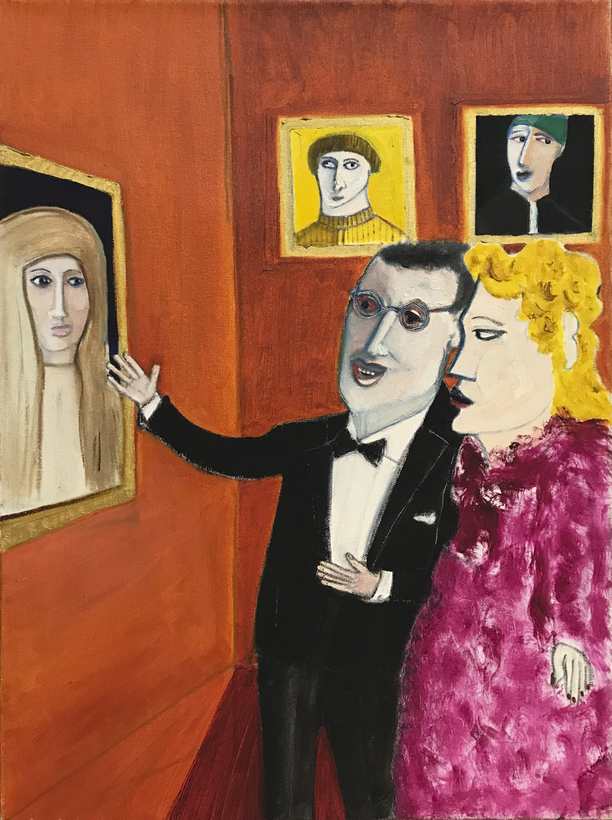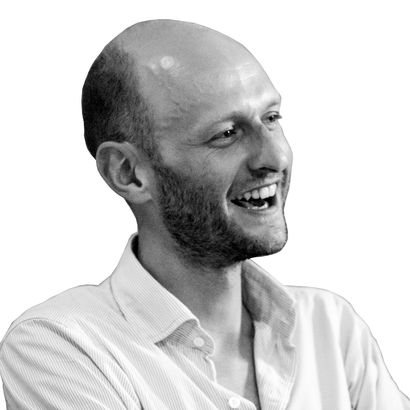“When artists talk about their work, it’s often total bullshit,” says Michael Lindsay-Hogg, whose exhibition “Talking Pictures” opens today at Hudson Hall, in upstate New York where he lives, and features 85 paintings. “But,” he continues, “the organization of little cubes, or the distortion of the head, or whatever, shows me a kind of order—and that helps my mood, because chaos has been controlled.”
Lindsay-Hogg, now 83, forged a career from chaos. After dropping out of Oxford in 1960, he found his way to directing, beginning in 1965 with the British music show Ready Steady Go! “When I worked with the Rolling Stones, I wanted to embrace the rock ’n’ roll chaos. Most of the shows at the time were very conventional—wide shots, over-the-shoulders, close-ups. I thought, ‘There’s a whole other way of doing this,’ and wanted to get in the chaos. I wanted to be like one of those planes that tracks storms.”

In 1968, he directed The Rolling Stones Rock and Roll Circus, which was shelved until 1996. In 1969, he made the Beatles movie Let It Be, cajoling the four into their final concert, on a rooftop in London. (That footage remained largely unseen until 2021, when Peter Jackson reworked it into the film Get Back.) Lindsay-Hogg then moved on to a splendid film-and-stage career, directing episodes of Brideshead Revisited for television and Whose Life Is It Anyway? on Broadway.

It was a freak accident in 1986 that made Lindsay-Hogg think about the relationship between chaos and painting. “The daughter of friends was killed one night stepping out of a bar—by a drunk driver. I was terribly shocked,” he says. “There was a show at the Met of pictures by Picasso and Matisse, on loan from Russia. I found myself there at nine in the morning. The paintings somehow made sense, when this hit-and-run made no sense.” A decade later, Lindsay-Hogg’s wife, Lisa, persuaded him to buy some canvases and paints.

The director transitioned from moving images to still, but his figurative work retains a cinematic feel. Compositions are partly imagined, partly lifted, from hundreds of postcards he keeps on rotating display stands. Working solo, Lindsay-Hogg is free to fashion his actors until he’s satisfied. “I didn’t know if they were going to be doctors or scientists,” he says of one painting. “I thought it would be interesting to put white lab coats on them, so it looks like they should know what they’re doing. But their faces make it look like they’re not sure.” Other times his decisions are less cryptic. “If there is a gap, maybe I’ll put something there, like a child or a turtle.” His colors and shapes, meanwhile, recall German Expressionism—a movement born from the chaos of W.W. I.

The show has been curated by Lindsay-Hogg’s friends Carol McCranie and Javier Magri. “They worked in the art world and have a good eye. They came over and worked with Lisa as curators.” Their selection criteria? “How the body of work comes together to make a good show. Some portraits, some bigger works, some smaller ones,” he says with a smile and a shrug. “It’s like a meal, with hors d’oeuvres, main course, and dessert. The works are currently with the framers to make them look posh.” And despite a career now entering its sixth decade, Lindsay-Hogg still bears a worry about his work’s reception. “I just hope I end up in the non-total-bullshit category!”
“Michael Lindsay-Hogg: Talking Pictures” is on at Hudson Hall, in Hudson, New York, until June 2
Harry Seymour is a London-based art historian and writer


